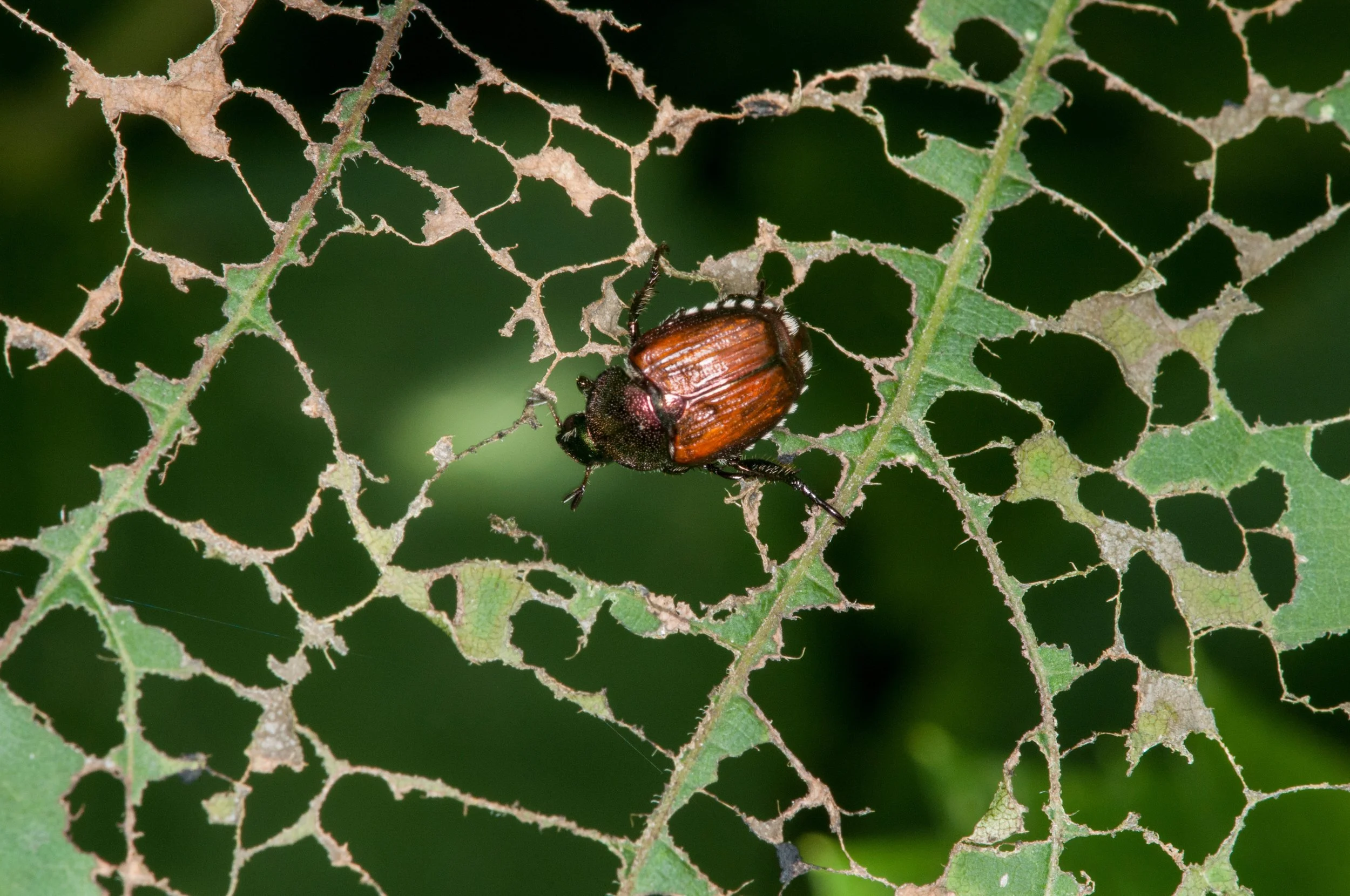Ask OGS: Japanese Beetles
Dear OGS,
This is my second year at gardening and I am wondering what to do about Japanese Beetles. Last fall I lay down the milky spore and that has seemed to help some. I spray with a soap/oil solution, sanafad?...pick them off. They are devouring everything. Anything else to try? Not gonna use poisons.
Thank you for your time,
Rhonda
———
Dear Rhonda,
Japanese Beetles can be discouraging, and it is a bit nerve-wracking when they arrive in droves and decimate your plants seemingly overnight. It sounds like you are taking the proper steps already, but (Yikes!) you are still dealing with lots of beetles.
Japanese beetles were first discovered in the United States in 1916 and are now present in most states east of the Mississippi River, as well as in a few western states. They are beautiful bugs, having 3/8” long metallic-green bodies with iridescent copper-colored wing-covers. Japanese beetles feed on the foliage, flowers, and fruit of a wide variety of plants, but have a preference for about 50 different plants. Some of their favorite foods are roses, Japanese maples, apples, peaches, plums, cherries, grapes, raspberries, crape myrtles, linden, and birches. Commercially, they can compromise corn and soybean crops. As they feed, they will skeletonize or destroy plant leaves. They love to eat rosebuds. They send out an APB when they find likable food, and feeding females release powerful sex pheromones that will quickly attract males in droves.
Japanese beetles typically emerge in June and July, remaining active for about a month. They mate and lay their eggs primarily in grass and lawns. The eggs hatch in late summer or fall, and the grubs begin feeding on plant roots until the weather cools. They overwinter in the ground and resume feeding in spring when temperatures rise. Japanese beetle grubs feed on a variety of plant roots, but they have a particular preference for grasslands and lawns, with Kentucky bluegrass and tall fescue—both common in mountainous areas—being among their favorites.
Options for Controlling Japanese Beetles
Handpicking
While many gardeners are comfortable squashing insects and destroying their eggs by hand, Japanese beetles can be more challenging. When disturbed, they often drop to the ground and disappear. Using a bowl of soapy water to brush them into is an effective alternative to jars, as the wider opening captures more beetles. Handpicking is most effective in the morning, when beetles are sluggish. According to Linda Blue, Buncombe County Extension agent, handpicking is one of the most effective control methods. This is because spraying insecticides may only kill beetles present at that moment, with new arrivals appearing the following day.
Milky Spore
Milky Spore works by targeting the grub stage of Japanese beetles. It contains the bacterium Paenibacillus popilliae (formerly Bacillus popilliae), which kills grubs by infecting and consuming them from the inside out. Milky Spore is safe for humans, pets, beneficial insects, wildlife, and aquatic life. It is available in powder and granular formulations.
The powder needs to be applied only once, any time the ground is not frozen (10 ounces treats 2,500 sq. ft.), placed every 4 feet in teaspoonfuls (each containing 100 million spores).
The granular version, packaged in 20-lb. bags to cover 7,000 sq. ft., should be applied with a drop spreader three times a year for two years.
Watering in the spores after application is recommended. The granular type covers the entire lawn surface, increasing the chances of grubs ingesting spores. Each infected grub releases about 3 billion new spores into the soil, allowing populations to build over 15–20 years. Spore multiplication is slower in colder climates like the Northeast.
Japanese Beetle Traps
These traps use either a sex pheromone or food-scent bait to lure beetles. While effective at attracting beetles, they can draw more into a garden than would naturally occur. If used, traps should be placed far from the target plants and emptied daily. Limiting use to a few days per week may help reduce excessive attraction.
Insecticidal Soap
For best results, the soap must contact the beetles directly. Application in the early morning, when beetles are sluggish, is recommended.
Surround®
Surround® is a kaolin clay mixed with water and sprayed onto plants. Commonly used on fruits and vegetables, its white coating confuses pests and irritates them. The non-toxic residue can be washed off before eating.
Floating Row Cover
Lightweight spun polypropylene fabric can protect plants while allowing rain and sunlight through. Row covers can be wrapped around specific plants or used to cover small gardens entirely, preventing beetle access while leaving room for growth.
Beneficial Insects
Natural enemies such as the parasitic wasps Tiphia vernalis and T. popilliavora, and the tachinid fly Istocheta aldrichi, help control Japanese beetles. Planting fennel, dill, and Queen Anne’s Lace supports these beneficial species.NEEM: Applying Neem Oil as soon as beetles are spotted can help diminish feeding. Apply every 7 days while beetles are feeding. To prevent leaf burn and to avoid hurting honeybees, spray Neem Oil late in the evening.
Neem Oil
Neem oil applied as soon as beetles appear can reduce feeding damage. It should be applied every seven days during beetle activity, preferably in the evening to prevent leaf burn and protect pollinators.
Pyrethrin
Derived from chrysanthemum flowers, pyrethrin can quickly immobilize beetles but must be sprayed directly on them. Coverage should include both tops and undersides of leaves.
Mycotrol
Containing the fungus Beauveria bassiana strain GHA, Mycotrol infects and kills insects without harming mammals, birds, or plants. However, it may harm bees and should not be applied near active foraging areas.
Spinosad
Found in products like Monterey Garden Insect Spray and Captain Jack’s Dead Bug Brew, Spinosad is derived from the bacterium Saccharopolyspora spinosa. While not specifically labeled for Japanese beetles, it is effective against leaf-eating beetles. Evening application helps protect honeybees.
Geranium Petals
Research suggests that when Japanese beetles consume geranium petals, they become temporarily paralyzed and vulnerable to predators, though they often recover within a day.
Other Home Methods
Vacuuming beetles off plants.
Creating a deterrent spray from blended beetles.
Applying garlic spray.
Wearing aerator sandals or running a lawn aerator to damage grubs in soil.
Although no single method completely eliminates Japanese beetles, using a combination of these strategies can significantly reduce their presence. Interestingly, these beetles are known to prefer feeding on poison ivy and multiflora rose.
Thanks for writing,
OGS
This blog post, written and copyrighted by Ruth Gonzalez, was originally published as part of a previous Organic Growers School article series called "Ask Tom," which addressed the growing concern. Some updates may have been made by OGS staff to keep the content current.


